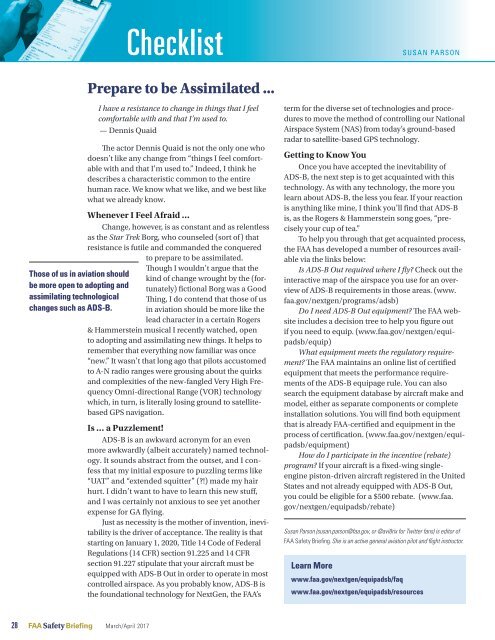Safety ADS-B
MarApr2017
MarApr2017
You also want an ePaper? Increase the reach of your titles
YUMPU automatically turns print PDFs into web optimized ePapers that Google loves.
Checklist<br />
SUSAN PARSON<br />
Prepare to be Assimilated ...<br />
I have a resistance to change in things that I feel<br />
comfortable with and that I’m used to.<br />
— Dennis Quaid<br />
The actor Dennis Quaid is not the only one who<br />
doesn’t like any change from “things I feel comfortable<br />
with and that I’m used to.” Indeed, I think he<br />
describes a characteristic common to the entire<br />
human race. We know what we like, and we best like<br />
what we already know.<br />
Whenever I Feel Afraid …<br />
Change, however, is as constant and as relentless<br />
as the Star Trek Borg, who counseled (sort of) that<br />
resistance is futile and commanded the conquered<br />
to prepare to be assimilated.<br />
Though I wouldn’t argue that the<br />
Those of us in aviation should<br />
kind of change wrought by the (fortunately)<br />
fictional Borg was a Good<br />
be more open to adopting and<br />
assimilating technological Thing, I do contend that those of us<br />
changes such as <strong>ADS</strong>-B.<br />
in aviation should be more like the<br />
lead character in a certain Rogers<br />
& Hammerstein musical I recently watched, open<br />
to adopting and assimilating new things. It helps to<br />
remember that everything now familiar was once<br />
“new.” It wasn’t that long ago that pilots accustomed<br />
to A-N radio ranges were grousing about the quirks<br />
and complexities of the new-fangled Very High Frequency<br />
Omni-directional Range (VOR) technology<br />
which, in turn, is literally losing ground to satellitebased<br />
GPS navigation.<br />
Is … a Puzzlement!<br />
<strong>ADS</strong>-B is an awkward acronym for an even<br />
more awkwardly (albeit accurately) named technology.<br />
It sounds abstract from the outset, and I confess<br />
that my initial exposure to puzzling terms like<br />
“UAT” and “extended squitter” (?!) made my hair<br />
hurt. I didn’t want to have to learn this new stuff,<br />
and I was certainly not anxious to see yet another<br />
expense for GA flying.<br />
Just as necessity is the mother of invention, inevitability<br />
is the driver of acceptance. The reality is that<br />
starting on January 1, 2020, Title 14 Code of Federal<br />
Regulations (14 CFR) section 91.225 and 14 CFR<br />
section 91.227 stipulate that your aircraft must be<br />
equipped with <strong>ADS</strong>-B Out in order to operate in most<br />
controlled airspace. As you probably know, <strong>ADS</strong>-B is<br />
the foundational technology for NextGen, the FAA’s<br />
term for the diverse set of technologies and procedures<br />
to move the method of controlling our National<br />
Airspace System (NAS) from today’s ground-based<br />
radar to satellite-based GPS technology.<br />
Getting to Know You<br />
Once you have accepted the inevitability of<br />
<strong>ADS</strong>-B, the next step is to get acquainted with this<br />
technology. As with any technology, the more you<br />
learn about <strong>ADS</strong>-B, the less you fear. If your reaction<br />
is anything like mine, I think you’ll find that <strong>ADS</strong>-B<br />
is, as the Rogers & Hammerstein song goes, “precisely<br />
your cup of tea.”<br />
To help you through that get acquainted process,<br />
the FAA has developed a number of resources available<br />
via the links below:<br />
Is <strong>ADS</strong>-B Out required where I fly? Check out the<br />
interactive map of the airspace you use for an overview<br />
of <strong>ADS</strong>-B requirements in those areas. (www.<br />
faa.gov/nextgen/programs/adsb)<br />
Do I need <strong>ADS</strong>-B Out equipment? The FAA website<br />
includes a decision tree to help you figure out<br />
if you need to equip. (www.faa.gov/nextgen/equipadsb/equip)<br />
What equipment meets the regulatory requirement?<br />
The FAA maintains an online list of certified<br />
equipment that meets the performance requirements<br />
of the <strong>ADS</strong>-B equipage rule. You can also<br />
search the equipment database by aircraft make and<br />
model, either as separate components or complete<br />
installation solutions. You will find both equipment<br />
that is already FAA-certified and equipment in the<br />
process of certification. (www.faa.gov/nextgen/equipadsb/equipment)<br />
How do I participate in the incentive (rebate)<br />
program? If your aircraft is a fixed-wing singleengine<br />
piston-driven aircraft registered in the United<br />
States and not already equipped with <strong>ADS</strong>-B Out,<br />
you could be eligible for a $500 rebate. (www.faa.<br />
gov/nextgen/equipadsb/rebate)<br />
Susan Parson (susan.parson@faa.gov, or @avi8rix for Twitter fans) is editor of<br />
FAA <strong>Safety</strong> Briefing. She is an active general aviation pilot and flight instructor.<br />
Learn More<br />
www.faa.gov/nextgen/equipadsb/faq<br />
www.faa.gov/nextgen/equipadsb/resources<br />
28 FAA <strong>Safety</strong> Briefing March/April 2017



